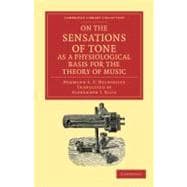
Note: Supplemental materials are not guaranteed with Rental or Used book purchases.
Purchase Benefits
Looking to rent a book? Rent On the Sensations of Tone As a Physiological Basis for the Theory of Music [ISBN: 9781108001779] for the semester, quarter, and short term or search our site for other textbooks by Helmholtz, Hermann L. F.; Ellis, Alexander, J.. Renting a textbook can save you up to 90% from the cost of buying.
| Notice by the translator | |
| Author's preface to the first German edition | |
| Author's preface to the third German edition | |
| Introduction | |
| On the Composition of Vibrations | |
| On the sensation of sound in general | |
| On the composition of vibrations | |
| Analysis of musical tones by sympathetic resonance | |
| On the analysis of musical tones by the ear | |
| On the differences in the quality of musical tones | |
| On the apprehension of qualities of tone | |
| On the Interruptions of Harmony | |
| Combinational tones | |
| On the beats of simple tones | |
| Depth and deepest tones | |
| Beats of the upper partial tones | |
| Beats due to combinational tones | |
| Chords | |
| The Relationship of Musical Tones | |
| General view of the different principles of musical style in the development of music | |
| The tonality of homophonic music | |
| The consonant chords of the tonal modes | |
| The system of keys | |
| Of discords | |
| Laws of progression of parts | |
| Esthetical relations | |
| Appendices | |
| Table of Contents provided by Publisher. All Rights Reserved. |
The New copy of this book will include any supplemental materials advertised. Please check the title of the book to determine if it should include any access cards, study guides, lab manuals, CDs, etc.
The Used, Rental and eBook copies of this book are not guaranteed to include any supplemental materials. Typically, only the book itself is included. This is true even if the title states it includes any access cards, study guides, lab manuals, CDs, etc.